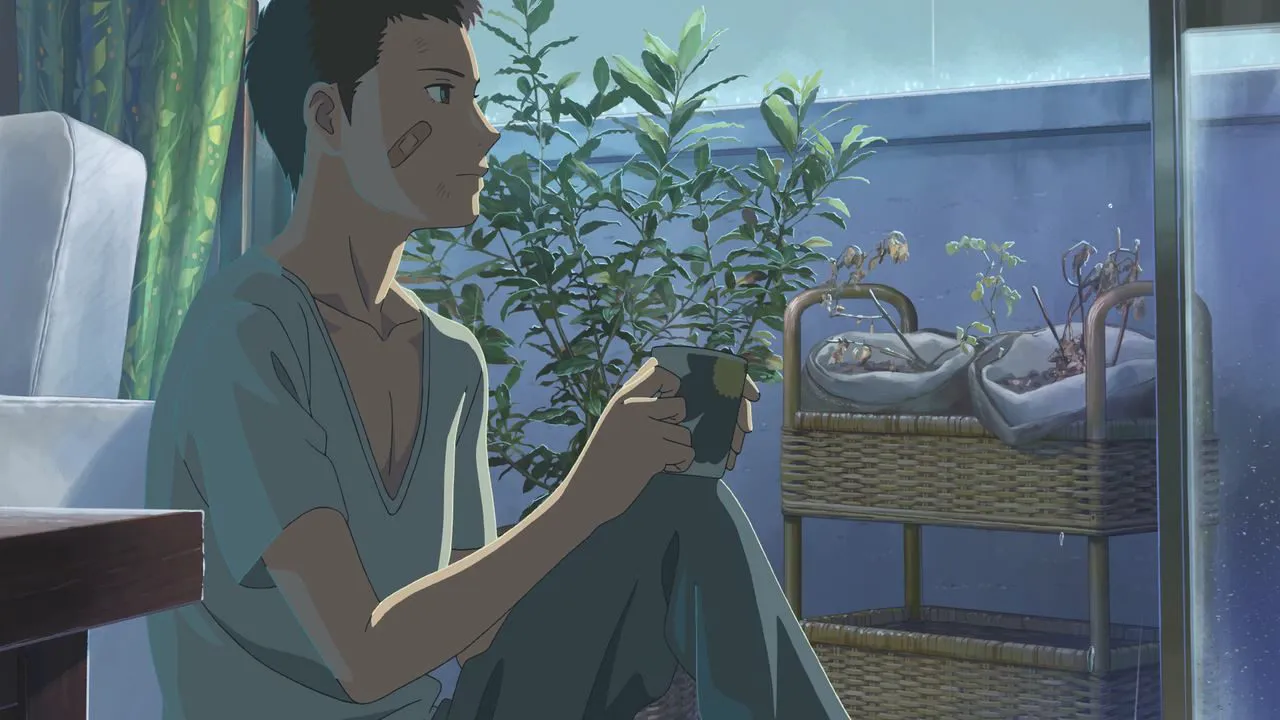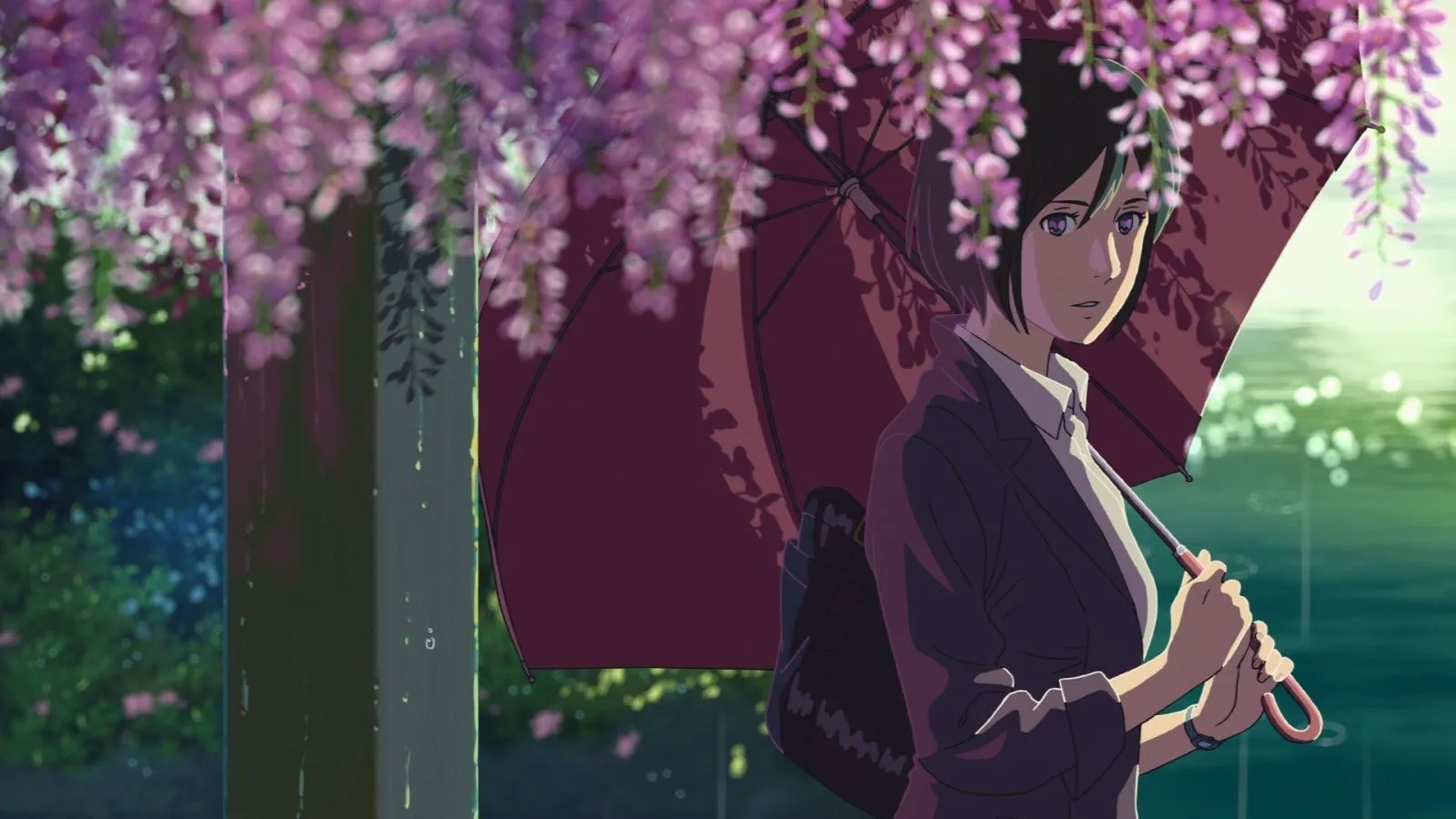The Garden of Words: A Rainy Day Reverie
In Tokyo, the rainy season arrives five days ahead of schedule. Amidst the throngs of students and adults navigating crowded subway cars, dodging wet umbrellas, high schooler Takao Akizuki slips away. Since childhood, he’s preferred the gloom of rain to the sun’s glare, so it’s no surprise that Takao only skips class on the cloudiest days, seeking refuge in Shinjuku Gyoen National Garden. There, in a gazebo sheltered by rain-soaked cryptomeria trees, he encounters Yukari Yukino, a 27-year-old teacher with unconventional tastes: she pairs chocolate with beer, quotes ancient tanka poetry, and wears shoes deemed too extravagant for her profession. With each passing overcast day, the two grow closer, sharing fears and dreams, exchanging bento boxes and memories, until the rainy season inevitably ends.

A scene from “The Garden of Words”
Makoto Shinkai: Beyond Fantasy
Makoto Shinkai’s name is often associated with fantastical narratives. He gained international recognition in 2016 with “Your Name,” an anime film where fantasy elements began to overshadow the everyday realism of his earlier works. Since then, Shinkai’s projects have consistently topped box office charts, leading to comparisons with animation master Hayao Miyazaki. However, this comparison feels somewhat irrelevant, considering the contrasting approaches of the two auteurs: where Miyazaki transforms the personal into the universal, Shinkai does the opposite.

A scene from “The Garden of Words”
Common Threads in Shinkai’s Works
Loneliness and coming-of-age, first love, nostalgia for youth and past attachments, and the obligatory cat cameo – these are hallmarks of every Shinkai film, regardless of genre. From his early short films (“Other Worlds,” “She and Her Cat”), he developed his signature style and consistently revisited familiar themes. Shinkai has become known for repetitive plots and recurring visual motifs, such as clouds symbolizing dreams or railway crossings foreshadowing separation. But the truly recognizable “Shinkai-esque” scenes emerged not in 2016, but in 2013.
The Garden of Words: A Masterpiece of Nuance
“The Garden of Words” didn’t achieve the same resounding success as “Your Name” or “Suzume” upon its theatrical release. Yet, it’s arguably Shinkai’s most mature and visually stunning anime, despite its shorter runtime (46 minutes) and complete absence of fantastical elements. The director encapsulates his core themes within this concise format, elevates an adult character from a supporting role, and radically refines his visual approach.

A scene from “The Garden of Words”
Visual Poetry in Motion
Shinkai previously used rotoscoping, with the photorealistic backgrounds in “5 Centimeters Per Second” captivating audiences almost more than the dramatic plot. However, the combination of rotoscoping, traditional animation, and CGI in “The Garden of Words” creates a completely different impact. Rain constantly falls, filling the screen with glistening reflections. The visuals are built upon reflections in water, puddles, wet asphalt, glass, subway car windows, and even a smartphone screen. The sky isn’t always hidden by clouds; sunlight pierces through the rain-soaked foliage, creating a komorebi effect, and sunbeams dance across the characters’ faces. Computer graphics were crucial in achieving the realistic physics of these phenomena.
Shinkai also borrows visual techniques from live-action cinema: panning shots, alternating static and fast-paced editing, time-lapses, and handheld camera movements. He pays meticulous attention to detail, often focusing on ordinary, everyday objects: a boiling kettle, L’Occitane hand cream, books by Antoine de Saint-Exupéry and Natsume Soseki, carefully rolled tamagoyaki, and Diana shoes, which appeared in Shinkai’s early short films. All of this contributes to the authenticity of the story, which would feel schematic and unconvincing without the visual richness. Recounting the plot of “The Garden of Words” while preserving its underlying meaning is nearly impossible – the narrative is simple and almost fades away: boy meets girl, boy falls in love, boy undergoes transformation, something happens to the boy and girl, open ending.
The Power of Visual Storytelling
The visuals fill the narrative gaps: natural phenomena embody the characters’ inner states, albeit in a reversed manner – rain symbolizes joy, and sunshine represents sadness. Seemingly insignificant details contribute to understanding the characters and inevitably lead to identification with them. Words alone, even eloquent ones, are insufficient to paint the complete picture. Because Shinkai’s characters – whether adults who are only nominally older than teenagers, or children not yet ready to take a step forward – are undeniably alive; they are ordinary people. Through interaction and relationship-building, they grow, let go of the past, and learn to stand on their own two feet, whether for the first time or anew. And it doesn’t matter how old they are or whether it will rain today.